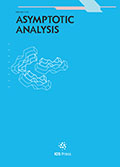Authors: Fiedler, Bernold | Vishik, Mark I.
Article Type:
Research Article
Abstract:
For rapidly spatially oscillating nonlinearities f and inhomogeneities g we compare solutions uε of reaction–diffusion systems ∂t uε =aΔuε −f(ε,x,x/ε,u)+g(ε,x,x/ε) with solutions u0 of the formally homogenized, spatially averaged system ∂t u0 =aΔu0 −f0 (x,u0 )+g0 (x,u0 ). We consider a smooth bounded domain x∈Ω⊆$\mathbb{R}^{n}$ , n≤3, with Dirichlet boundary conditions. We also impose sufficient regularity and dissipation conditions, such that solutions exist globally in time and, in fact, converge to their compact global attractors 𝒜ε and 𝒜0 , respectively, in L2 (Ω). Based on ε‐independent a priori estimates we prove
…‖uε (·,t)−u0 (·,t)‖L2 (Ω) ≤Cε eρt , uniformly for all t≥0 and 0<ε≤ε0 . Here the solutions uε and u0 start at the same initial condition u=u0 (x)∈H1 (Ω) for t=0, and C=C(‖u0 ‖H1 ). Based on an ε‐independent H2 ‐bound on the global attractors 𝒜ε as well as an exponential attraction rate ν of the homogenized attractor 𝒜0 in L2 (Ω), we also prove fractional order upper semicontinuity of the global attractors for $\varepsilon\searrow 0$ , distL2 (Ω) (𝒜ε ,𝒜0 )≤Cεγ′ for γ′=(1+ρ/ν)−1 . This result requires the homogenized nonlinearity f0 (x,w) to be near a potential vector function f1 (x,w)=∇w F(x,w) with scalar potential F. Both quantitative homogenization estimates are proved only for quasiperiodic dependence of f,g on the spatially rapidly oscillating variable x/ε. Moreover, the finitely many frequencies describing this quasiperiodic dependence are assumed to satisfy Diophantine conditions, as are familiar from small divisor problems in Kolmogorov–Arnold–Moser theory. Alternatively, the results hold if f, g admit a sufficiently regular divergence representation which describes their explicit spatial dependence. All results apply to, and are illustrated for, the case of FitzHugh–Nagumo systems with spatially rapidly oscillating quasiperiodic coefficients and inhomogeneities. For an earlier preprint version of the present paper see [6]. In the companion paper [7], based on analytic semigroup methods, similar results are obtained for the quantitative homogenization of solutions and invariant manifolds. Examples include homogenization of the Navier–Stokes system under periodic boundary conditions and for spatially rapidly oscillating quasiperiodic forces. For a recent extension to strongly continuous semigroups with an application to damped hyperbolic wave equations see [8].
Show more
Citation: Asymptotic Analysis,
vol. 34, no. 2, pp. 159-185, 2003
Price: EUR 27.50




